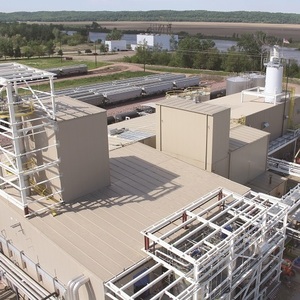First commercial US biodiesel plant completes major expansion

Photo: AGP
August 25, 2017
BY Ron Kotrba
AGP recently completed a major expansion project at its Sergeant Bluff, Iowa, biodiesel production facility—the nation’s first commercial-scale biodiesel plant, built in 1996. Production capacity at AGP’s Sergeant Bluff biodiesel plant doubled from 30 to 60 MMgy. The biodiesel expansion project was first announced November 2015.
Officials at the company told Biodiesel Magazine that the biodiesel expansion project was completed July 23 and the plant is now operating at its increased annual capacity.
The biodiesel expansion project was coupled with construction of AGP’s new on-site soybean oil refinery, which supplies feedstock to the biodiesel plant.
AGP’s Sergeant Bluff complex in Iowa now features integrated soybean processing, soybean oil refining and large-scale biodiesel production.
Advertisement
Advertisement
AGP owns nine soybean processing facilities across the Midwest—with its tenth currently under construction in Aberdeen, South Dakota—and three biodiesel production facilities with installed capacity totaling 150 MMgy.
Advertisement
Advertisement
Related Stories
The USDA maintained its outlook for 2025-’26 soybean oil use in biofuel production in its latest World Agricultural Supply and Demand Estimates report, released Aug. 12. The forecast for soybean oil prices was also unchanged.
U.S. soybean production for 2025 is forecast at 4.29 billion bushels, down 2% when compared to last year, according to the USDA National Agricultural Statistics Service’s latest monthly Crop Production report, released Aug. 12.
California’s new specified source feedstock attestation requirement: A critical new compliance step for renewable fuel producers
As of July 2025, California’s SCFS requires renewable fuel producers using specified source feedstocks to secure attestation letters reaching back to the point of origin. This marks a significant shift in compliance expectations.
At the University of Missouri, plant biochemist Jay Thelen is using arabidopsis as a powerful model to explore ways to boost oil production — an important step toward creating more sustainable, plant-based energy sources.
Iowa farmers have a new market opportunity for their 2025 soybean crop. Landus is expanding its Clean Fuel Regulation initiative, made possible by recent policy changes expected to increase Canada's demand for liquid biofuel.
Upcoming Events










